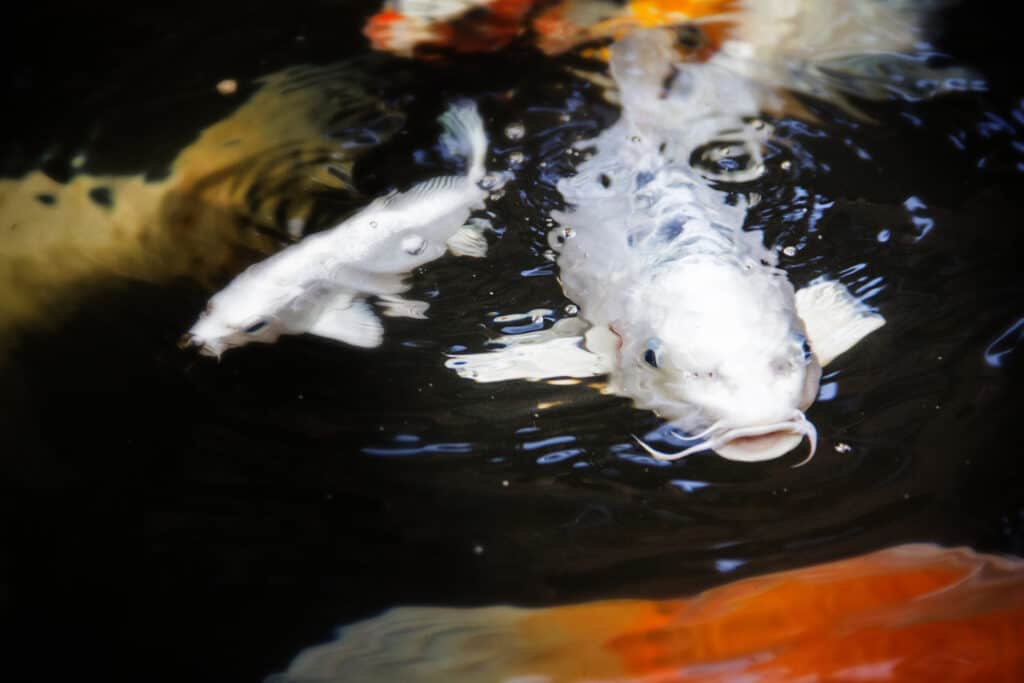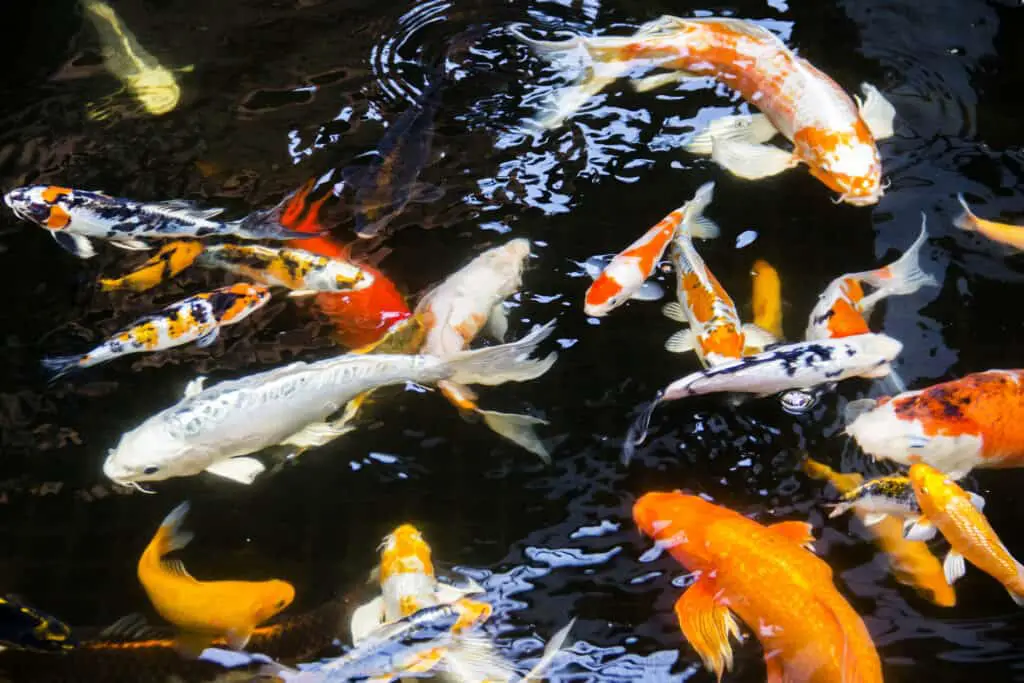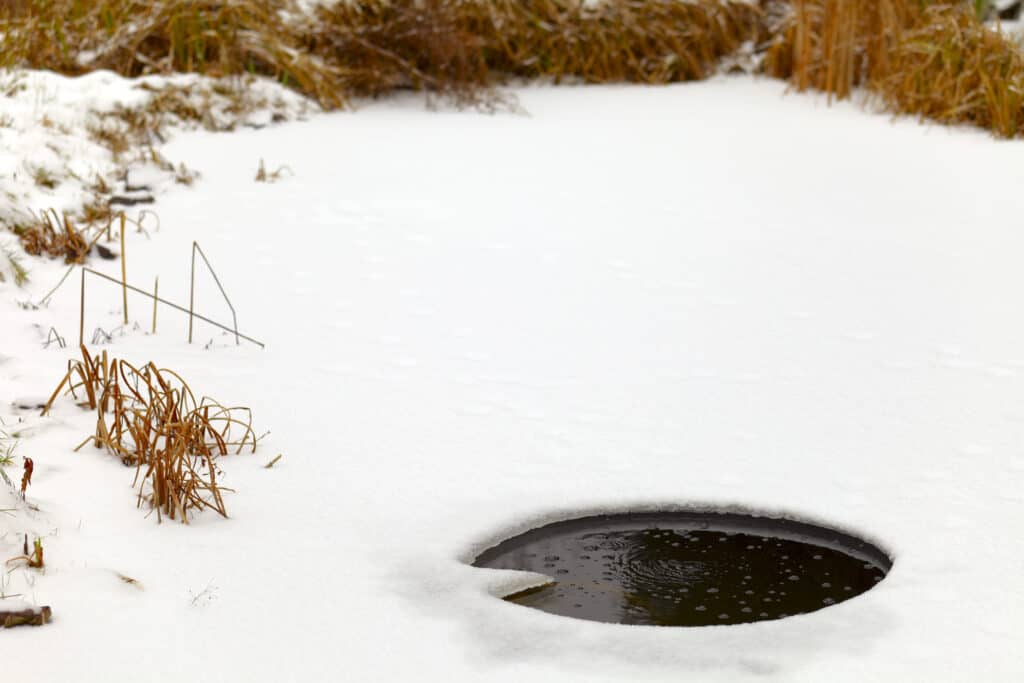
Koi fish are poikilothermic (cold-blooded), so the temperature of the water they live in determines their body temperature, metabolic rate, activity levels, how much they feed, and how much they grow. Koi fish are naturally adapted to living in cold water between 59- and 77-degrees F. Can koi survive in water colder than this?
Koi fish can tolerate when the top of the pond ices over. Koi can survive in temperatures as low as 33.8 degrees F, but at 60 degrees F, a koi fish’s immune system starts to slow. At 50 degrees F, koi’s metabolism slows significantly, and they stop feeding. At 45 degrees F, they go into torpor.
You can still have an outdoor koi pond if you live in a place with freezing winters, but you may have to give your fish some special care and maintain the pond regularly. Here, we discuss the effect that cold temperatures have on koi and how to keep koi alive during the icy winter months.
Pro Tip: If you’re tired of wasting money and making costly mistakes on the koi-keeping hobby or are thinking about buying koi fish but don’t know where to start, I strongly suggest you check out this ebook. I recently read this ebook, and it contains SO much useful information, such as:
- 3 proven steps to identify koi fish diseases
- WARNING: 3 things you should NEVER do when it comes to caring for koi
- When to seek professional help when it comes to looking after your koi
How Cold Is Too Cold For Koi Fish?
Koi fish originate from Japan, a region of the world where winter temperatures regularly dwindle to around 25 degrees F. Koi are a cold-water species. They are adapted to surviving in cold water. But how cold can koi fish tolerate?
Koi fish can tolerate a minimum temperature of 33.8 degrees F. That is not to say that they can live in water that cold. Koi fishes’ bodies begin slowing down at water temperatures below 65 degrees F.
The lowest temperature that koi pond water can be on average throughout the year is 59 degrees F. You should keep the water in a koi pond warmer than this to keep the fish healthy.
Can Koi Fish Live Under Ice?
If a koi fish freezes in a block of ice, they die. They do not have any special ability to survive their bodies freezing.
However, koi fish can survive when the surface of the pond water freezes over. They can only do this if the pond is more than 2 feet deep. One has to maintain a small hole in the ice to keep the water aerated.
What Is The Optimal Water Temperature For Koi Fish?
Koi fish prefer living in water that stays between 59- and 77-degrees F. As a rule, you should aim to keep a koi pond’s water at around 70 degrees F.
But why is this the best temperature for koi fish?
Koi fish, like all other fish, do not have the ability to regulate their own body temperature. They are cold-blooded, just like reptiles, so the temperature of their environment determines their body temperature.
The water temperature in a koi pond needs to be above 60 degrees F because that is the temperature above which a koi’s body temperature is high enough to support a well-functioning metabolism.
A koi’s metabolic rate governs everything in their lives – how much energy they have to swim, feed, and grow. If the water temperature is below optimal, their metabolisms will function below optimal.
Is Cold Water Good For Koi Fish?

Cold water is good for koi fish. They are adapted to living in cold water, so they are healthiest when the water is below 77 degrees F. Koi fish cannot live in water that is too warm.
There are limits to how much cold is beneficial for koi. Let’s look at what happens inside koi’s bodies at very cold temperatures:
- Below 65 degrees F, koi fishes’ immune systems are impeded by the cold. At 65 degrees F, koi’s immune systems function at around half their maximum efficiency. At 60 degrees F, they only function at 20% efficiency.
- At 60 to 65 degrees F, beneficial bacteria and pathogens are still active in the water. Because koi still feed normally at these temperatures, and the pond filter works well, the koi’s immune systems can still fend off diseases.
- Below 50 degrees F, koi’s immune systems only function at around 10% efficiency. Koi’s metabolic rate slows significantly in water this cold. They stop feeding almost completely.
- Below 45 degrees F, koi go into a state known as torpor. Their metabolic rate is minimal, they stop eating, and their immune systems hardly function.
- Parasites that thrive in cold water, like Costia and Chilodinella, are a danger to koi because of their weakened immune system.
- Below 40 degrees F, koi struggle to survive because they have almost no immune system, and their metabolisms do not function. They start to develop internal problems that are difficult to recover from.
- Koi will start to die at 33.8 degrees F.
Is It Bad For Koi To Go Into Torpor?
Torpor is a naturally occurring state that almost all animals can enter to survive extreme conditions. But does this mean that torpor is good for koi?
When an animal’s metabolic rate slows down, it takes a toll on its body. It makes them far more susceptible to diseases and infections. They do not grow, and their bodies cannot heal.
When koi go into torpor, they hang around the bottom of the pond, staying very still. If they rub their undersides on the bottom of the pond, they can develop ulcers or lesions. If these become infected, it can kill the fish.
Koi fishes’ immune systems cannot protect them from certain pathogens and parasites when they are in torpor. This can weaken them further, even killing them.
Can Koi Fish Stay Outside During Winter?
Koi fish need special care during the coldest months of the year. Koi pond owners have different ways of protecting their fish during winter. People who have enough space take koi inside over winter and keep them in a tank or indoor pond.
However, this is just not practical for most pond owners. Is it possible for koi fish to stay outside in their pond during winter?
Thankfully, yes! If your koi pond is more than 2 feet deep and you take extra care to maintain the pond, koi fish can live outside over winter.
Some people erect a temporary greenhouse over their koi pond for winter. This helps to keep the aquatic plants in and around the pond alive too. It also works to put a solar cover over the pond to keep the water warm.
The way most people keep their koi outside during winter is by installing a heater to keep the water in the pond warm. They also place a de-icer or an air pump in the pond to keep a hole in the ice and keep oxygen levels in the water up. This is also so that the pond can de-gas.
It is important to stop the pond’s water pump and filter before winter so that water does not circulate around the pond. The warmest water sinks to the bottom, and you want to keep a layer of warm water trapped at the bottom of the pond for the koi to live in.
How To Care For Koi Fish During Winter

Keeping koi alive and healthy during winter requires some effort on your part. As temperatures decrease, koi fishes’ nutritional needs change.
When temperatures begin dropping in the fall, keep a close eye on the thermometer in your koi pond. This is an important time to take the best possible care of your fish to prepare them for winter.
If koi fish are not overwintered properly, they can be unhealthy in spring, when temperatures warm up again. They will look dull, struggle with diseases and parasites, and will not grow as quickly.
Stop Feeding Koi Fish During Winter
When the water dips below 50 degrees F, you must stop feeding koi. Koi fish will still feed at these temperatures, but they will not be able to digest it efficiently. Excess uneaten food in the pond will contaminate the water.
Do not fret about your koi going hungry! During the spring and summer months, they build up fat reserves in their body to sustain them over winter. It is perfectly okay to not feed koi for up to 6 months of the year!
Keep A Hole In The Ice If Your Koi Pond Freezes Over
If the pond water ices over, you must maintain a hole in the ice. This is so that the pond can release gases that are produced in the water and so that the water can remain oxygenated.
Never hit the ice with a hammer or sharp object to try and break a hole in the ice! The sudden impact on the ice sends a shockwave through the water that can kill your fish.
Use hot water (dechlorinated!) to melt a hole in the ice near the shallowest part of the pond. Maintain the hole by placing a de-icer or bubbler near the hole. If the surface of the water stays moving, it will keep the hole from freezing over again.
Install A Water Heater Over Winter
A heating system can keep pond water just above 50 degrees F, or you can maintain the water at summer temperatures throughout winter.
The latter will mean that you can keep feeding your koi all winter. They will stay active and keep feeding and growing all year round.
In most cases, a pond heater helps to keep the water just above 50 degrees F during winter so that your fish do not go into torpor.
Do Not Circulate Koi Pond Water During Winter
In a pond that is deeper than 2 feet, koi fish can survive over winter in the bottom layer of water. Water is most dense at 39.16 degrees F. It sinks to the bottom of the pond.
The water above this layer can be much colder, and the pond can even freeze over, but the koi fish will safely survive at the bottom of the pond. That is if you do not circulate the pond water!
Shut down the pond’s water pump and switch off any water features over winter. These can stir up the water at the bottom of the pond, cooling it further.
Medicate Koi During Winter
Koi fish are extremely vulnerable to infections and health problems when the water temperature is between 60- and 45-degrees F. This is when the koi’s immune systems are suppressed, but bacteria are still active in the water.
You can medicate koi to keep the fish safe while the temperatures are in this range. Treating the water with potassium permanganate at a concentration of 2ppm has immense therapeutic benefits. It protects koi from Aeromonas bacteria.
Feed koi medicated feed during the fall to support their immune systems. Medicated koi feed contains antibiotics.
Some products on the market are enzyme-based. The enzyme outcompetes Aeromonas bacteria for nutrients in the water, thereby reducing their populations. These products are excellent to use in the fall and the spring.
Should You Move Koi Fish Indoors Over Winter?
For ponds shallower than 2 feet, or if you cannot practically maintain your pond outdoors during winter, you should bring your fish inside over winter to keep them warm.
Depending on the size of your koi and the number of fish, you need a 100 to 1000-Gallon tank. Buy a polytank, as a glass tank of this size is way too heavy to practically move. The tank water must be treated and dechlorinated before you put the fish in!
You have to keep the top of the tank covered so that the koi do not jump out. Heat the water in the tank and run an air pump to keep oxygen levels up.
If you have enough enclosed space, you can keep koi in an indoor pond of around 4000 Gallons. If you do not have the space, a 300-Gallon holding tub can work, depending on the number of koi and their size.
Conclusion
Koi fish can live in cold water. Being a cold-water species, they need cold water to survive. Koi fish are happiest in water between 59- and 77-degrees F. But koi fish do not enjoy too much cold! In temperatures below 60 degrees F, their immune systems lose efficiency, and below 50 degrees F, their digestive systems slow down significantly. Below 45 degrees F, koi enter a state of torpor.
Therefore, koi pond owners must take special care of their fish in late fall, over winter, and early spring. Koi fish must not be fed when the water is below 50 degrees F. Pond owners can install a water heating system to keep water warm. They can also use a bubbler or small air pump to maintain a hole in the ice if their pond freezes over.
Resources
https://mpks.org/cold-water-care-of-koi-by-bryan-bateman-akca-koi-health-advisor/ https://www.kodamakoifarm.com/winter-koi-pond-preparation-survival/

